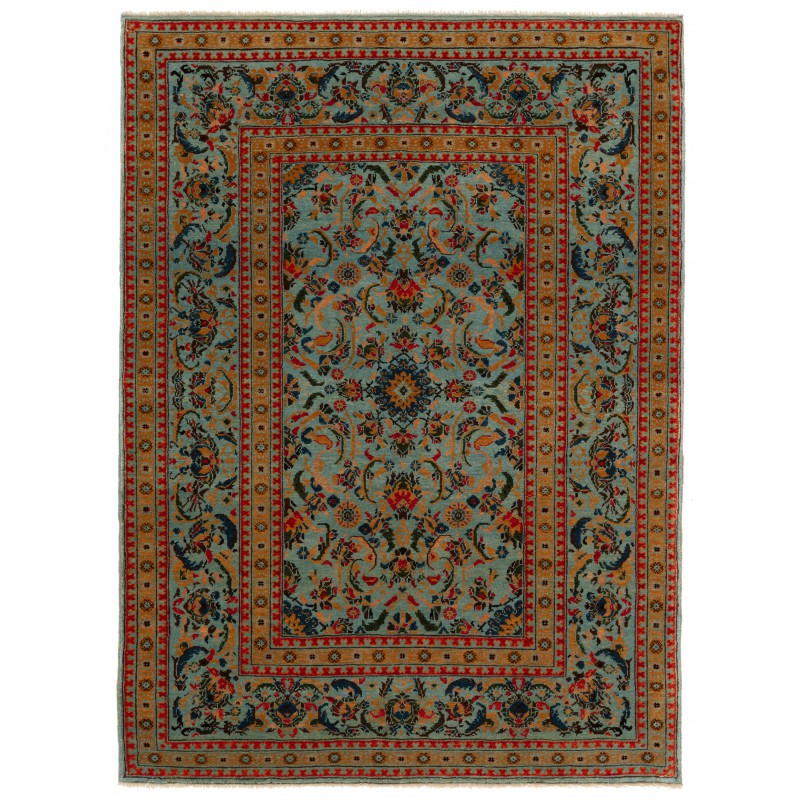
トルコ宮廷製造絨毯 Turkish Court Manufactury Rug
460,000円
税込み: 460,000円
- Stock: In Stock
- Model: C50304
- サイズ: 164cm x 122cm
トルコ宮廷製造絨毯は、オスマン帝国によって16世紀にエジプトの工房で織られました。これらの絨毯は、おそらくイスタンブールで作成され、当時カイロに送られた紙の模様書に基づいてエジプトで織られました。オスマンリトルコ人によるエジプトの征服直後(1517年)、エジプトでは様式の変化が起こりました。イスタンブールの宮廷向け工房の設立により、絨毯産業で特に強い表現が見られました。カイロのオスマン帝国の絨毯は、材料やカラーレンジにおいて前の時代の絨毯と一致しており、パレットは黄色、白色、およびいくつかの他の色の使用が増えることで拡張されています。ただし、時折、カイロの基本色の3色に満足する傾向もあります。それにもかかわらず、その製造の継続性について疑念が示されたことがあるとすれば、これは新しい絨毯が完全にそれまでの装飾の方向性を放棄したという事実に基づいています。植物は時には自然主義的で、時には特異な方式でスタイライズされて、豊かに展開され、トルコの壁タイルやブロケードで知られる形状が終わりのない連続性でフィールドを埋め尽くし、しばしば四分円をコーナーに繰り返し配置した大きなまたは小さなメダリオンによって中断されます。カーネーション、チューリップ、ヒヤシンス、ユリ、牡丹などの花々は、優雅な弧を描くランセット状の葉、豪華なヤシの葉、繊細な花の花束と共に、これらの絨毯の豊かな植物相を構成しています。ボーダーはエレガントな解決策で角の問題を魅力的に演出し、ガードストライプではほぼ必ず小さなロゼットの花が一列に並んで現れます。マムルークの伝統に基づいたものがまだ見られることは稀であり、一方で、デザインの革新は早くも少数の見本で予告されています。純粋な民族芸術では、このような抜本的な変革は考えられませんが、工場の運営では、まったく新しいプログラムを導入することが最小限の混乱で実現できます。この絨毯のデザインは解釈され、元の絨毯に合わせるために最適な色が使用されます。
Turkish Court Manufactury Rugs were woven in the Egyptian workshops founded by Ottoman Empire in the 16th century. Those carpets were woven in Egypt, following the paper cartoons probably created in Istanbul and sent to Cairo at that time. Shortly after its conquest by the Osmanli Turks (1517), a change of style was set in Egypt which, due to the establishment of a manufactory working for the court in Istanbul, found a particularly strong expression in the carpet industry. The Cairene Ottoman carpets correspond with those of the previous period both in material and in color range, and the palette is extended only through the more plentiful use of yellow, white, and a few other tints; occasionally, however, they were inclined to be satisfied with the three Cairene basic colors. Nevertheless, if there have been doubts expressed regarding the continuity of their production, these were based entirely upon the fact that the new rugs renounced completely the decorative orientation which had been observed up to that point. Vegetation which at times is naturalistic, at times stylized in a peculiar manner, is deployed luxuriantly and, in forms that are known to us from Turkish wall tiles and brocades, quite fills the field in endless continuation, interrupted by a large or a small medallion, quadrants of which are often repeated in the corners. Carnations, tulips, hyacinths, lilies, peonies, and other flowers, together with gracefully sweeping lancet leaves, sumptuous palmettes, and delicate sprays of blossoms, constitute the rich flora of these carpets, whose borders charm the eye with their elegant solutions for the corner problem, while in the guard stripes almost invariably little rosette-flowers appear all in a row. It is merely by way of exception that we will still find appropriations levied upon the Mamluk tradition, while, on the other hand, the coming revolution in decor is already heralded in a few specimens which we still count as belonging to the earlier group. In pure folk art, such a radical overturn would be quite inconceivable, but then in the operation of a manufactory, the introduction of a completely novel program can be accomplished with a minimum of confusion. With this change of orientation, it was significant that the idea of a governing medallion, even if with a different conception, had already been put to use. The design of this rug is interpreted and the most appropriate colors to match the original is used for this rug.
- Opal 533 (ヘナ - 藍)
- Sunray Color 405 (ヘナ)
- Natural Wool Color 37 (羊そのままの色)
- Imperial Red 426 (茜)
上の番号は私たちのカラーコードです。()の中は、主な草木染めの材料です。
タグ:
マムルーク
